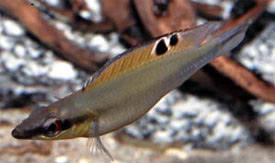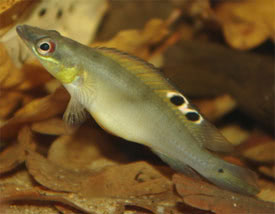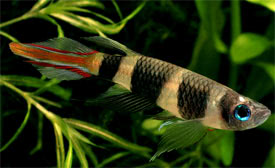
 Magyarul / Hungarian
Magyarul / Hungarian



- Scientific name: Crenicichla regani
- Synonyms: -
- Common name: Regan's pike cichlid
- Group: Cichlids
- Habitat: South America; Brazil
- Size: 14 cm.
- Biotope: Broadly distributed in the Amazon Basin, in clear, acid (pH 5.5) and extremely soft waters.
- Social behavior: It is social towards equal-sized cichlids. Males however, are hostile among themselves.
- Diet: Carnivorous; feeds on small fish and crustaceans in nature. In the aquarium give them small frozen foods (Artemia, mosquito larvae), plankton and worms.
- Breeding: Quite hard
- Tank: Minimum 200 litres.
- Population: 1 pair for 200 litres
- Decoration: Abundant hiding places among rocks, roots and plants - including small caves - should be offered.
- Temperature: 24-26 °C
- pH: 5,5-6,5
- Hardness: 4-10 NK°
- Lifespan: 5-8 years
Description: Males have a brown to grey dorsum, a beige ventrum, and ochre or red-brown fins. The caudal fin has a design, and the anal and dorsal fins are elongated. Unlike Crenicichla notophthalmus, the first rays of the dorsal fin are not extended. At the same locality the females have yellow dorsal fin with 1-3 white-fringed ocelli or several black spots. Sometimes the spots create a zigzag design. Exceptionally, the entire dorsal fin below the fringe is black. The fringe of the dorsal fin anteriorly consists of an orange, a black, and a broad white stripe, but the posterior dorsal fin has just a narrow black outline. All females have stubby dorsal and anal fins, and their caudal fin has no design.
Large servings of live food can be used to get the fish into breeding condition. The female initiates courtship by splaying her fins, curving her body, and flashing her beige or pink ventral area at the male. This behavior is continued until the male reciprocates by extending his fins and circling the female. Aftewards they both retire to a cave and spawn on the ceiling. A fully grown female can produce around 150 eggs per spawning. The eggs, which are tended by the female, hatch within 3 days (pH 7.2, 3° dGH, 6 °KH, 25 °C). Four days later, the fry are free-swimming. Live Artemia nauplii are a good first food. Later Cyclops, Daphnia, and grindal worms can be added. The young are 4 cm long at 3 months of age.













